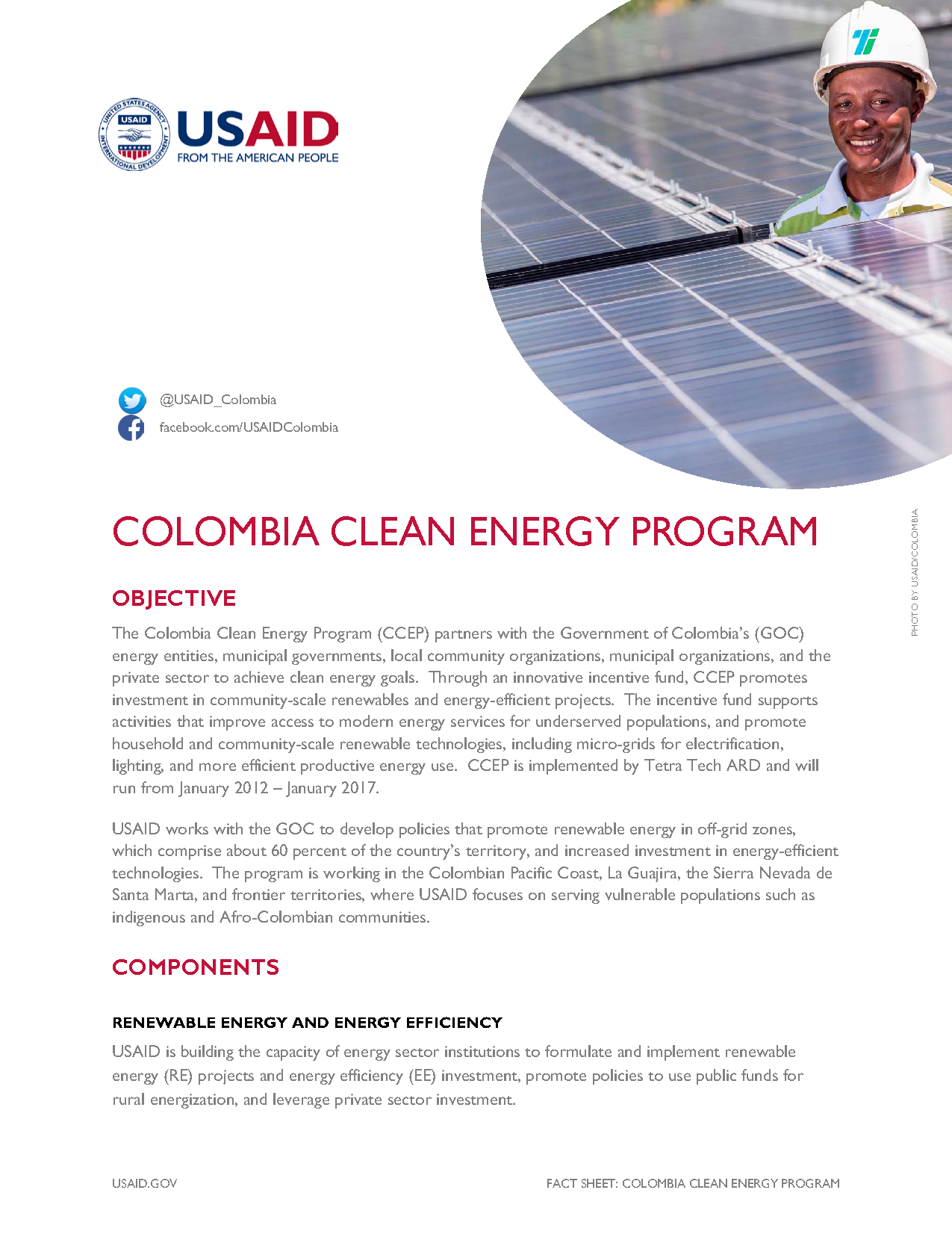Colombia Clean Energy Program Fact Sheet ![]() (pdf - 200k)
(pdf - 200k)
OBJECTIVE
The Colombia Clean Energy Program (CCEP) partners with the Government of Colombia’s (GOC) energy entities, municipal governments, local community organizations, municipal organizations, and the private sector to achieve clean energy goals. Through an innovative incentive fund, CCEP promotes investment in community-scale renewables and energy-efficient projects. The incentive fund supports activities that improve access to modern energy services for underserved populations, and promote household and community-scale renewable technologies, including micro-grids for electrification, lighting, and more efficient productive energy use. CCEP is implemented by Tetra Tech ARD and will run from January 2012 – January 2017.
USAID works with the GOC to develop policies that promote renewable energy in off-grid zones, which comprise about 60 percent of the country’s territory, and increased investment in energy-efficient technologies. The program is working in the Colombian Pacific Coast, La Guajira, the Sierra Nevada de Santa Marta, and frontier territories, where USAID focuses on serving vulnerable populations such as indigenous and Afro-Colombian communities.
COMPONENTS
Renewable Energy and Energy Efficiency
USAID is building the capacity of energy sector institutions to formulate and implement renewable energy (RE) projects and energy efficiency (EE) investment, promote policies to use public funds for rural energization, and leverage private sector investment.
Expanding Access to Renewable Energy Sources in Off-grid or Under-served Areas
USAID is stimulating the development of sustainable renewable energy projects in rural communities through micro hydro power plants, solar power, and hybrid energy systems, among others. USAID works on clean energy projects for communities in Antioquia, Chocó, La Guajira, Sierra Nevada de Santa Marta, and Valle del Cauca, serving vulnerable groups such as indigenous and Afro-Colombian communities.
Renewable Energy and Energy Efficiency Investment Promotion
USAID is analyzing the feasibility of energy efficiency opportunities to guide future project investments. In alliance with national businesses and the financial sector, energy efficiency/renewable energy projects are being structured and promoted in ceramic, glass, and brick manufacturing; agro-industrial food and beverage; and the metal and textile subsectors.
RESULTS
- Partnered with over 100 public and private agencies and institutions, leveraging and/or mobilizing over $18.9 million in public and private funding. This resulted in $4.55 mobilized/leveraged per $1 invested by USAID.
- Created income opportunities for more than 300 families using solar-powered refrigeration for the community of Punta Bonita (Río Cajambre – Buenaventura) to support the fishery value-chain.
- Installed 38 water pumping systems (with solar or mechanically assisted technology) in three municipalities in La Guajira, in alliance with Fundación Cerrejón Guajira Indígena.
- Completed two micro hydro power plants, and trained local residents on their use and maintenance, in Ciénaga (Magdalena) and Nuquí (Chocó).
- Completed one hybrid (solar/diesel) energy system in Buenaventura, in alliance with Empresa de Energía del Pacífico. This is the first of its kind in Colombia supported by the private sector.
- Installed 10 renewable energy systems in health posts along the Colombian border; 35 solar-powered coffee mills in coffee farms in Serranía del Perijá; and one system with solar refrigeration in a Wayuu boarding school in Siapana, La Guajira.
- Improved access to energy services for 10,775 people; an additional 7,613 people will benefit from projects under closure.
- Reduced 55,120.85 metric tons of CO2 equivalents, decreasing the quantity of greenhouse gas emissions, representing 882,932.32 MWH in energy savings (or the equivalent of running almost 300 million residential homes for an hour).








Comment
Make a general inquiry or suggest an improvement.